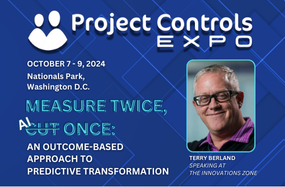
Measure Twice, AI Once: An Outcome-Based Approach to Predictive Transformation

In the fast-evolving world of construction, the implementation of Artificial Intelligence (AI) is no longer a futuristic vision but a present reality. Construction companies are increasingly embracing AI to streamline operations, enhance design accuracy, and boost overall project efficiency. However, the approach taken in deploying AI significantly impacts the success and return on investment of these initiatives.
The well-known adage “measure twice, cut once” is about the importance of meticulous planning and execution to avoid costly future mistakes. “Measure Twice, AI once” adds a new modern twist to that adage and underscores the importance of careful planning and precision, when it comes to choosing the right AI strategy. Among the options available, Outcome-Based AI Strategies stand out as a superior approach compared to Capabilities-Based Approaches.
Understanding the Two Approaches
Before delving into why Outcome-Based AI Strategies are more effective, it’s essential to understand the distinction between the two approaches:
Capabilities-Based Approaches focus on the capabilities that AI can bring to the table, such as machine learning algorithms, data processing power, or specific AI tools. The implementation of AI in this approach is driven by the desire to leverage these capabilities, often without a clear roadmap on how they will align with the organization’s strategic goals.
Outcome-Based AI Strategies, on the other hand, start with the end in mind. These strategies focus on achieving specific, predefined results that align with the company’s broader objectives. The AI tools and technologies are then selected and deployed based on their ability to deliver these desired outcomes.
The Pitfalls of Capabilities-Based Approaches
While Capabilities-Based Approaches can be enticing due to the allure of cutting-edge technology, they often lead to challenges:
- Misalignment with Business Goals: Implementing AI for the sake of its capabilities can result in solutions that are technologically advanced but disconnected from the company’s strategic objectives. This misalignment often leads to underutilized resources and unmet expectations.
- Resource Drain: Focusing on AI capabilities can lead to significant investments in tools and technologies that may not directly contribute to the company’s bottom line. This can strain resources and lead to inefficiencies.
- Complexity without Clarity: AI systems are inherently complex and deploying them based on their capabilities alone can lead to confusion and a lack of clear direction. Teams may struggle to understand how to best utilize these systems, resulting in suboptimal performance.
The Advantages of Outcome-Based AI Strategies
Outcome-Based AI Strategies mitigate these risks by prioritizing clarity, alignment, and effectiveness:
- Strategic Alignment: By focusing on desired outcomes from the outset, Outcome-Based Strategies ensure that AI initiatives are directly tied to the company’s strategic goals. Whether the objective is to reduce project timelines, improve safety, or optimize costs, every aspect of the AI implementation is designed to support these specific outcomes.
- Efficient Resource Utilization: When the end goal is clear, companies can allocate resources more effectively. Instead of investing in the most advanced AI capabilities, resources are directed toward solutions that will deliver the highest impact, ensuring a better return on investment.
- Enhanced Decision-Making: With a focus on outcomes, teams can make more informed decisions about which AI tools and technologies to deploy. This approach reduces the risk of adopting technology for its own sake and instead emphasizes solutions that provide tangible benefits.
- Measurable Success: Outcome-Based AI Strategies allow for clear benchmarks and key performance indicators (KPIs) to be established from the beginning. This makes it easier to measure the success of AI initiatives and make data-driven adjustments as needed.
Why “Measure Twice, AI Once” Matters
The concept of “Measure twice, AI once” is the essence of Outcome-Based AI Strategies. It emphasizes the importance of careful planning and alignment before embarking on an AI initiative. By measuring—defining goals, understanding desired outcomes, and ensuring that AI solutions are tailored to achieve these results—companies can avoid the pitfalls of Capabilities-Based Approaches and ensure a more successful, impactful AI deployment.
In the construction industry, where precision and efficiency are paramount, choosing the right AI strategy is critical. Outcome-Based AI Strategies, which focus on achieving specific goals and desired outcomes, offer a more effective and aligned approach than Capabilities-Based Approaches. By adhering to the principle of “Measure twice, AI once,” AEC companies can ensure that their AI initiatives are not only technologically advanced but also strategically sound, delivering real, measurable value to the organization.
Where to Start to Achieve Outcome-Based AI Strategies Today?
LoadSpring provides construction companies with AI tools and digital transformation solutions that ensure successful, outcome-based AI initiatives.
Start your journey towards smarter AI deployment today by contacting our digital transformation experts today!








